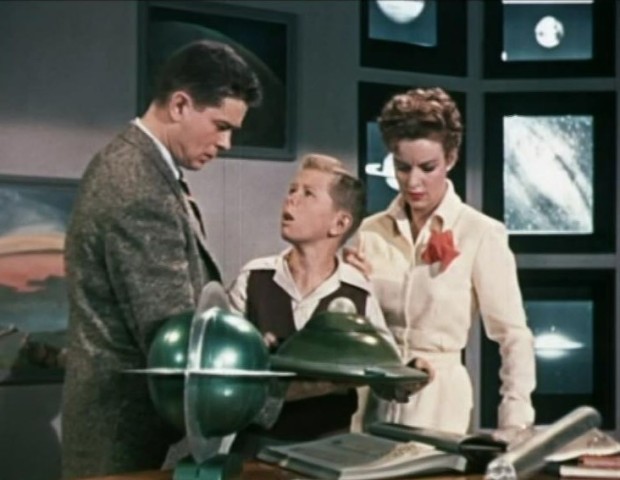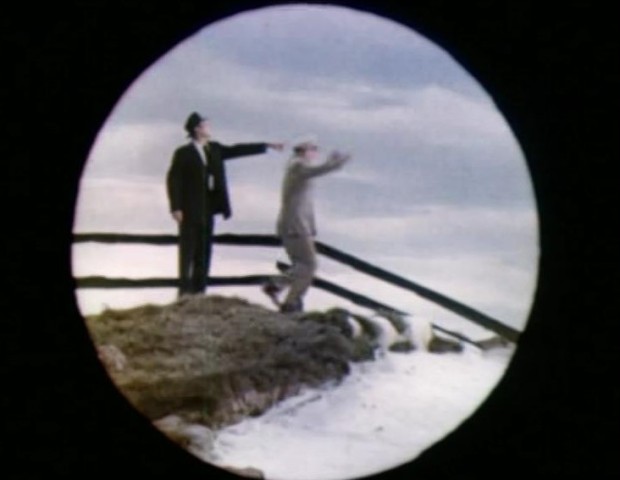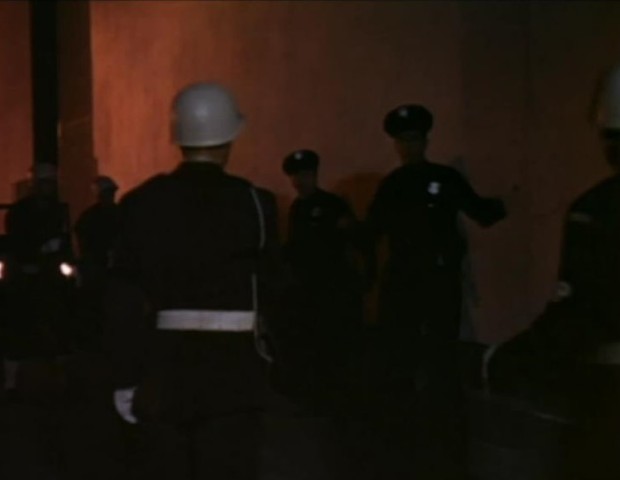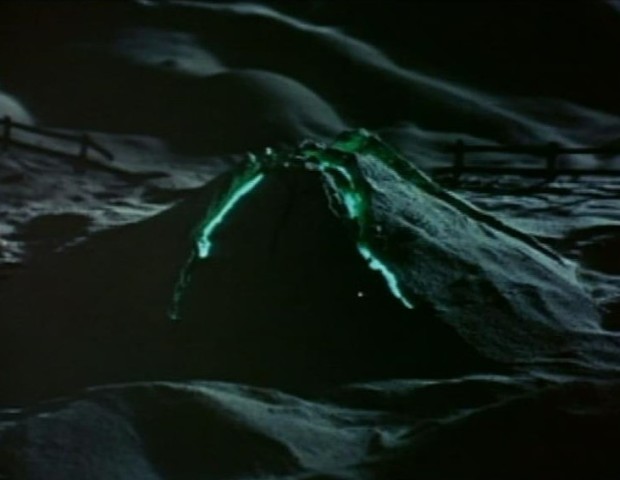The first recording today starts with the end of an episode of Bear Behaving Badly.
There’s a trail for Raven: The Secret Temple.
Then, after a long hiatus, it’s an episode of SMart – Elements.
It’s a signed showing. I’m not quite sure there’s enough wind to really get Mark’s hair like this.
They make windsocks decorated as carp.
Morph does a bit of unintentional kitesurfing.
Mark draws a picture of the Great Fire of London.
Mark visits an art project where a group of children help build a dragon sculpture of wood.
Then they set it on fire. Typical bloody kids.
There’s a short biography of Turner.
Mark draws the Weather.
They use a digger to make some bigger art.
In Arty Towers, they make some bubble painting.
Kirsten makes an underwater scene.
Here’s the big studio picture. I think it’s the end of V For Vendetta.
Media Centre Description: Mark Speight and Kirsten O’Brien present the programme that turns everyday objects into exciting and easy-to-make pictures, as well as answering art queries. Mark helps some Cornish viewers send a sculpture up in flames. Kirsten makes art for a windy day. And a digger driver creates a picture in the mud.
Recorded from CBBC Channel on Monday 12th November 2007 10:43
BBC Genome: CBBC Channel Monday 12th November 2007 10:45
After this, there’s a trail for Young Dracula.
Then the recording stops with the start of Get 100.
The other recording today starts with a trail for Brasil Brasil.
Then, we have a classic movie, which I’m surprised I never recorded on my tapes. It’s Invaders from Mars, the 1953 original, not the 1986 Tobe Hooper remake.
I love 1950s titles.
And you don’t often get the credit “Production Designed and Directed By”
Young David MacLean is a keen stargazer. His dad is an important scientist working somewhere secret.
Late at night, he’s woken up by a lot of noise, and sees a flying saucer appear to land somewhere behind his house. We see, but he doesn’t, that the saucer buries itself under the ground. He tells his father about it, and he goes out to see if there’s anything there, but he’s somehow taken underground.
In the morning, he hasn’t returned, so his wife calls the police, who go and look around. Then one of them falls into a newly appearing hole in the ground. Shortly followed by the other policeman.
David’s father returns, but he’s very sullen and miserable.
David notices a strange scar on his neck, and when he asks about it, his father hits him in the face.
David goes out and looks at where the saucer landed through a telescope, and he sees a little girl walk over there and disappear.
He goes over to the neighbour’s house and tells the girl’s mother that she disappeared, but as he’s telling her, the girl arrives at the door. She’s got the same impassive expression on her face as his father.
He runs out, and sees smoke coming from the house’s cellar. Someone has poured petrol down there and set it alight.
He goes to the police, but the police chief has also been changed, and orders him to be put into custody. But the thing I want to talk about is how, for a film that’s directed by the production designer, it has a lot of very minimalist sets. The police station has almost nothing in it, and I wonder how they wind that clock.
The desk sergeant, who hasn’t been taken over, calls for someone to come and see David. She’s Dr Pat Blake, from the city health department, and she listens to David’s story about the spaceship and how his father changed. He can’t quite believe it, so she phones a local astronomer Dr Stuart Kelston, who tells her he knows David. “He’s a pretty realistic young fella.”
David’s mother comes to pick him up, but his father is with her too, so she’s been taken over. Dr Blake prevents them from taking him by telling them that he’s developing Polio. She’s my favourite character so far.
She takes David to see Dr Kelston. “He’s my favourite astronomer” he says. Then there’s a very long exposition scene during which he talks about the possibility of life on other planets, and around other stars. He singles out one in particular just as an example – Wolf 359. Which I only knew as the location of a massive space battle in Star Trek The Next Generation and had just assumed it was made up. But it’s a real star. So now I’d really like to know if they used it in Star Trek as a reference to this film, or if it’s just a coincidence.
His lecture moves to more local places. “Here’s one of our artist’s conception of a Martian landscape.” “Grass, lakes, vegetation?” “They’ve got oxygen in their atmosphere, and water vapour too.” “And ice caps at either pole, just as we have.” “Still, what does all of this mean?” “That some form of life exists on Mars.” “But it looks so bleak and deserted.” He just showed an artist’s impression with grass and vegetation, and then says there might be some form of life. So what’s grass and vegetation then?
He then breaks out his collection of models of spaceships that people have “reported seeing.” He’s got all sorts of spaceships.
Even one that closely resembles the one David saw.
David gets to use the big telescope at the observatory. Kelston is still lecturing. “There isn’t enough oxygen on Mars, and the surface is too cold to support human life as we know it. There is a theory, consequently, that their cities are underground, near some central core of heat, or that they live in spaceships.” “You don’t believe that?” “I’m a scientist.” “But it can’t be proved.” “It can’t be disproved, either. Could you disprove, for example, that the Martians have bred a race of synthetic humans to save themselves from extinction?” “Synthetic humans?” “The theory calls them mutants.” He’s the worst scientist ever.
He shows them one possible reason why Martians might want to come to earth. There’s a rocket at a nearby airbase. He explains what it might be used for. “Then it’s merely a matter of time before we set up interplanetary stations, equipped with atomic power, and operated by remote control. And if any nation dared attack us, just by pushing a few buttons, we could wipe them out in a matter of minutes.” And he’s worked out a complete conspiracy theory-style explanation for everything. “What’s David’s father?” “He’s an engineer over at the Armistead Plant.” “What’s made at that plant, David?” “Gosh, I don’t know. Dad will never talk.” “Because the plant your dad works at is where the whole motor assembly for that rocket was made.” “But what did they want with little Kathy Wilson?” “Nothing, David. But Kathy’s father is Dr. William Wilson.” “The physicist?” “The man who conceived that rocket and whose house was burned down.”
They look at the place where the saucer landed, just in time to see David’s father bring General Mayberry there, and watch hm fall into the ground.
Kelston contacts the military to warn them, and there’s an interminable montage of tanks being loaded onto trains. There’s a lot of stock footage in this film.
They get news that young Kathy, the girl who burned her parents’ house down, died of a cerebral haemorrhage, so Dr Blake goes to see, and comes back with the cause – a tiny implant in her neck.
One of the local factories is blown up, and the two policemen who were converted earlier are found there. They both collapse as their implants kill them.
At the rocket base, General Mayberry is spotted, with two large cases. When he runs, guards shoot at him, and the cases explode, so he was clearly going to sabotage the rocket.
We meet Dr Wilson, the father of young Kathy, who’s processing his grief by getting on with all his sciencing. I don’t know how many physicists work by pouring coloured liquids into flasks, and having lots of bunsen burners, but I guess I just don’t understand all this advanced science.
Outside his building, David’s mother pulls up, and tells the guard her car isn’t running, and when he tries to help her, her husband whacks him over the head. Then he takes a rifle into the facility, and tries to shoot Dr Wilson, but luckily he happens to duck at exactly the right time. They drive away, but have a crash and are caught by the army and taken to a hospital.
The Army blast a hole where everyone has been disappearing, and finally see what’s under there, which is not much. They think the saucer must have moved underground.
Dr Blake gets news about David’s parents and takes him aside to tell him they’re being operated on to remove the implants. But as they’re talking, they hear the strange sound that’s preceded other disappearances, and they both vanish underground. I did wonder how the film would contrive to get David into the spaceship, because it was obvious that would have to happen.
We get our first very dark and murky look at the Martian “mutants”.
Two of them carry a ball containing another creature, presumably an actual Martian rather than a mutant. He doesn’t say an awful lot, so I’m assuming it’s all telepathy or something.
On the surface, the army use their special detectors to find out where the saucer has moved to, and they start laying charges to break through, while also bombarding other locations as a distraction. There’s an awful lot of explosions, all of which seem to be stock footage too.
Sergeant Rinaldi, who was sucked underground earlier, arrives to talk to David and Dr Blake. The shoulder of her dress has been ripped, but in a sexy way. She asks him who the strange creature is. “He is mankind, developed to its ultimate intelligence. These are his slaves, existing only to do his will, just as you will.” So an ultimate intelligence just defaults to total slavery? That’s a depressing thought.
There’s an awful lot of running around, explosions, and corridors. Dr Blake is prepped to have an implant
After more running about, shooting mutants and collapsing tunnels (I swear they use the same collapsing tunnel shot about six times in this movie) she’s rescued by Dr Kelston.
Just to ramp up the tension a bit more there’s a countdown to when the army’s explosives will blow up the ship.
But there’s still a search for David and Sgt Rinaldi, so it’s a race against time. But they’re all trapped by a tunnel collapse. They find David and Rinaldi, and David gets one of the mutants’ tunnelling guns to make a new exit. Sure enough, the same footage of a tunnel explosion.
The saucer starts emerging from the ground.
This isn’t the best print of the film – it’s probably an old telecine from a while back, and it’s got a lot of scratches, but this scene of Blake and Kelston running is just completely out of focus. Probably a telecine glitch, as I can’t imagine it would be this out of focus in the film.
The saucer flies up, but then the explosives go off.
Dr Blake reassures David about his parents. “With a control point destroyed, nothing can possibly happen to your mother and father now. They’re going to be all right.” “Gee, thanks.”
But we don’t see them again, and the last shot is David asleep under the watchful eye of Kelston and Blake, as if they’ve adopted him. Slightly weird.
Media Centre Description: Sci-fi classic. A young boy’s excitement at seeing a spaceship land outside his house quickly turns to fear when everyone who visits the site returns in a zombie-like state, apparently under the control of the alien life forms within the vessel.
Recorded from BBC FOUR on Monday 12th November 2007 22:00
BBC Genome: BBC FOUR Monday 12th November 2007 22:00
After this there’s a trail for Visions of the Future and Brasil Brasil. Then the recording stops with the start of a repeat of The Martians and Us.























































Looks like the version of Invaders from Mars you watched was an alternative cut; the US cut has an “It was all a dream.. OR WAS IT?” ending. This one has that one where the parents live, but David is adopted now for some reason, and that whole bit with the different spaceship models. Didn’t even know it had different cuts until now.
Wow, I had no idea there were alternate cuts. Thanks.